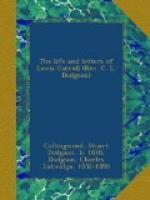It must be quite sixteen years now since he first made friends with my sister and myself as children on the beach at Eastbourne, and since then his friendship has been and must always be one of my most valued possessions. It culminated, I think, in the summer of 1892—the year when he brought me to spend a very happy Sunday at Guildford. I had not seen him before, that year, for some time; and it was then, I think, that the childish delight in his kindness, and pride in his friendship, changed into higher love and reverence, when in our long walks over the downs I saw more and more into the great tenderness and gentleness of his nature.
Shortly after Mr. Dodgson’s death, his “Three Sunsets” was published by Messrs. Macmillan. The twelve “Fairy Fancies,” which illustrate it, were drawn by Miss E. G. Thomson. Though they are entirely unconnected with the text, they are so thoroughly in accordance with the author’s delicate refinement, and so beautiful in themselves, that they do not strike one as inappropriate.
Some of the verses are strangely in keeping with the time at which they are published.
I
could not see, for blinding tears,
The
glories of the west:
A
heavenly music filled my ears,
A
heavenly peace my breast.
“Come
unto me, come unto me—
All
ye that labour, unto me—
Ye
heavy-laden, come to me—
And
I will give you rest.”
One cannot read this little volume without feeling that the shadow of some disappointment lay over Lewis Carroll’s life. Such I believe to have been the case, and it was this that gave him his wonderful sympathy with all who suffered. But those who loved him would not wish to lift the veil from these dead sanctities, nor would any purpose be served by so doing. The proper use of sympathy is not to weep over sorrows that are over, and whose very memory is perhaps obliterated for him in the first joy of possessing new and higher faculties.
Before leaving the subject of this book, I should like to draw attention to a few lines on “woman’s mission,” lines full of the noblest chivalry, reminding one of Tennyson’s “Idylls of the King":—
In
the darkest path of man’s despair,
Where
War and Terror shake the troubled earth,
Lies
woman’s mission; with unblenching brow
To
pass through scenes of horror and affright
Where
men grow sick and tremble: unto her
All
things are sanctified, for all are good.
Nothing
so mean, but shall deserve her care:
Nothing
so great, but she may bear her part.
No
life is vain: each hath his place assigned:
Do
thou thy task, and leave the rest to God.
Of the unpublished works which Mr. Dodgson left behind him, I may mention “Original Games and Puzzles”; “Symbolic Logic, Part ii.,” and a portion of a mathematical book, the proofs of which are now in the hands of the Controller of the Oxford University Press.




